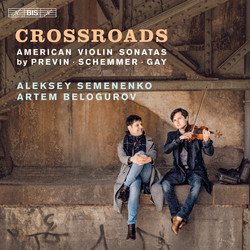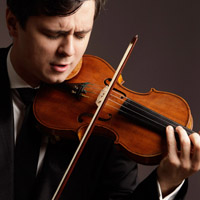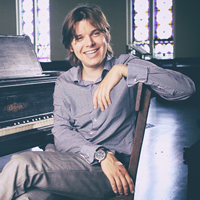Crossroads – American Violin Sonatas
Composers
Paul Gay
André Previn
Tony Schemmer
Performers
Aleksey Semenenko, violin
Artem Belogurov, piano
On this transatlantic disc, three American composers born during the first half of the last century rub shoulders with two young musicians from Eastern Europe. A member of the BBC New Generation Artists scheme, the violinist Aleksey Semenenko first met the pianist Artem Belogurov at the Stolyarsky Special Music School in Odessa at an early age. Even if their individual careers have taken to different parts of the world, the two still perform together whenever possible, and here they present three sonatas.
Of the composers, the best-known is André Previn who composed his Violin Sonata No. 2 in 2011 for Anne-Sophie Mutter. An improvisatory spirit permeates the work which is in three movements with the markings Joyous, Desolate and Brilliant. Tony Schemmer and Paul Gay are both based in the Boston area and share a background in which jazz and classical genres merge. This is reflected in their sonatas, composed in the 1980s and here appearing on disc for the first time.
Available on BIS Records.

Released November 2021
Paul Gay
Sonata for Violin and Piano (1984)
I. Introduction and Toccata
II. Sonnet
III. Idyll
IV. Games and Epilogue
Thoughts from the Composer
The violinist is one of the top handful of world violinists under age 35. The pianist is excellent and as comfortable in modern music as with authentic interpretation of Early Music. The complete work is 24 minutes in 4 movements. The last movement occupying 11 minutes is a summation of all that went before.
Overtly programmatic, it is a representation of 4 stages of serious personal relationships. Neither instrument exclusively represents the female or male.
I. “Introduction & Toccata” Attraction hinted at/expressed by her opening lament in the solo violin, a minor key phrase, interrupted by and completed by the other in the happier major. There follows more freedom to elaborate on the contrasting feelings of each. The second section, a toccata, ends on the dominant – a note most hopeful it seemed to Giovanni Gabrieli and to me.
II. Movement, “Sonnet”. His song. A not too forward expression of interest tiptoed into by descending pizzicatto violin notes, conveniently running out of violin range so the other protagonist takes the gambit by leading up into a simple little melody which gets tossed back and forth. It’s last note becomes the first note of the III Movement, her song, thus creating a connection between the two.
III. “Idyll”. Her song. This movement with a flowery opening, lighthearted and serene – until – doubt and jealously appear. That resolved it goes happily on in its initial serene style.
IV. “Games & Epilogue” is begun simultaneously by both, but with their very first notes in a competitive sharp dissonance then spiraling downward into the ‘chase – catch – escape’ game, with a continual repetition of that sequence. Interjected between those games are reminders of their path to this point and the significance of each of the preceding movements. When it finally quiets down there is an extended crab canon signifying a purity and strength of the relationship by being the same whether performed frontward or backward, then the soulful, noble ending. In the last measures the violin suggests her faux attempt of breaking away, but not to be.
— Paul Edward Gay
The recording was done at Mechanics Hall, Worcester, MA using a Model D Steinway Concert Grand piano, Frank Cunningham, Engineer, Maureen Amaral Producer.
Contributing Artists
 Aleksey Semenenko – After his Kennedy Center debut, the Washington Post wrote, “Semenenko … explored every corner of the composer’s imagination … a real triumph”. Shortly thereafter, the New York Times raved that his New York appearance was “particularly enriching” . Since winning the prestigious Young Concert Artists Auditions in New York in 2012 at the latest, the young violinist Aleksey Semenenko has belonged to the world’s elite violinists and can look forward to lively concerts in Europe and the USA, as a soloist and chamber musician.
Aleksey Semenenko – After his Kennedy Center debut, the Washington Post wrote, “Semenenko … explored every corner of the composer’s imagination … a real triumph”. Shortly thereafter, the New York Times raved that his New York appearance was “particularly enriching” . Since winning the prestigious Young Concert Artists Auditions in New York in 2012 at the latest, the young violinist Aleksey Semenenko has belonged to the world’s elite violinists and can look forward to lively concerts in Europe and the USA, as a soloist and chamber musician.
As the winner of the Boris Goldstein International Violin Competition in 2015, he was invited to perform at the Musical Olympus Festival in St Petersburg, where he received the Audience Award and then made his debut with the Moscow Philharmonic. In addition, he won 2nd prize at the renowned Queen Elisabeth Competition in Brussels, also in 2015. The violinist’s other awards include the “Artist of the Month” award from the “Musical America Worldwide” magazine.
The musician’s most recent engagements include appearances in the Berlin Philharmonic, the Cologne Philharmonic, the Philharmonic in Essen, the Louvre in Paris, the Palais de Beaux-Arts in Brussels, the Alice Tully Hall in New York, the Moscow Philharmonic and the Concertgebouw-Orkest in Amsterdam.
Born in Odessa in 1988, Aleksey started studying violin at the age of 6 with Zoya Merzalova, who also trained Yuri Bashmet. His talent was recognized early on, when he won a children’s music festival in Odessa just a year later and made his debut as a soloist with the Odessa Philharmonic Orchestra. Many important appearances followed quickly, including with the Moscow Virtuosos under the direction of Vladimir Spivakov.
After Aleksey Semenenko completed his concert exam studies with Zakhar Bron in Cologne, he is currently studying chamber music with Prof. Harald Schoneweg, also at the Cologne University of Music. He plays a Stradivarius violin from 1699, which was made available to him by the Deutsche Stiftung Musikleben.
 Artem Belogurov – Known equally for his “verve, wit, and delicatesse” (Boston Musical Intelligencer) and his “infinite tenderness” (Evening Odessa), Artem Belogurov has an extensive repertoire, ranging through four centuries of solo and chamber works. His interest in period performance leads him to historical keyboards, including clavichord, harpsichord, and fortepianos spanning the eighteenth and nineteenth centuries. As a soloist and in chamber groups, Artem has performed in a wide variety of venues, among them Lincoln Center, Library of Congress, Jordan Hall, Harvard Musical Association, the Universität der Kunste in Berlin, the Musikhochschule in Hanover, St Andrews University in Scotland, Tivoli Vredenburg in Utrecht, and Muziekgebouw in Amsterdam. His critically acclaimed album of solo piano works by the late nineteenth century American Romantic composers, recorded on a Chickering piano built in 1873, was released by the London-based label Piano Classics in 2015. 2019-2020 season includes a North American tour with Concerto Köln as a soloist and continuo player, performances with his duo partner cellist Octavie Dostaler- Lalonde and with the early music ensemble Postscript, of which he is a founding member. Artem won first and second prizes at international competitions in the Netherlands, Germany and Japan. After studying modern piano at the New England Conservatory in Boston, Artem moved to Amsterdam where he studied fortepiano and clavichord at the Conservatorium van Amsterdam with Richard Egarr and Menno van Delft and graduated receiving cum laude in 2016.
Artem Belogurov – Known equally for his “verve, wit, and delicatesse” (Boston Musical Intelligencer) and his “infinite tenderness” (Evening Odessa), Artem Belogurov has an extensive repertoire, ranging through four centuries of solo and chamber works. His interest in period performance leads him to historical keyboards, including clavichord, harpsichord, and fortepianos spanning the eighteenth and nineteenth centuries. As a soloist and in chamber groups, Artem has performed in a wide variety of venues, among them Lincoln Center, Library of Congress, Jordan Hall, Harvard Musical Association, the Universität der Kunste in Berlin, the Musikhochschule in Hanover, St Andrews University in Scotland, Tivoli Vredenburg in Utrecht, and Muziekgebouw in Amsterdam. His critically acclaimed album of solo piano works by the late nineteenth century American Romantic composers, recorded on a Chickering piano built in 1873, was released by the London-based label Piano Classics in 2015. 2019-2020 season includes a North American tour with Concerto Köln as a soloist and continuo player, performances with his duo partner cellist Octavie Dostaler- Lalonde and with the early music ensemble Postscript, of which he is a founding member. Artem won first and second prizes at international competitions in the Netherlands, Germany and Japan. After studying modern piano at the New England Conservatory in Boston, Artem moved to Amsterdam where he studied fortepiano and clavichord at the Conservatorium van Amsterdam with Richard Egarr and Menno van Delft and graduated receiving cum laude in 2016.
Reviews of “Crossroads”
SACD Review by Michael De Sapio For the American “Fanfare Archive” periodical
PREVIN Violin Sonata No. 2. SCHEMMER Violin Sonata. P. GAY Violin Sonata • Aleksey Semenenko (vn); Artem Belogurov (pn) • BIS 2545 (SACD: 71:12)
I responded so favorably to Crossroads: American Violin Sonatas, for here are three composers—two of them still living—who continue the craftsmanship, seriousness of purpose, and tonal communicativeness of the best mid-20th-century American music. These sonatas offer no Postmodern spoofery, nor avant-garde aural assaults. All three composers deftly mix popular elements with their classical technique yet in a way that is integral and natural.
The sonata of Maine-born Paul Gay (b. 1936) is the loveliest on the disc. Gay’s muse is gentle, mellow, poetic, and endearing. The spontaneous lyricism suggests an early spring day in New England. There is a pristine formal clarity, a concern for craft, and a respect for tradition here that would have pleased Gay’s fellow Maine composer Walter Piston. The very titles of the movements show a Neoclassical clarity of purpose: “Introduction & Toccata,” “Sonnet,” “Idyll,” “Games & Epilogue.” This is an elegant and deeply felt work.
The performances of the Ukrainian musicians are faultless and idiomatic, as is the recorded sound. This delightful disc afforded some new discoveries for me and comes strongly recommended.
Excerpt from a review by German music critic Martin Blaumeiser for Klassik Heute.
The CD Bis Records release of “Crossroads”, three American Sonatas for Violin & Piano with compositions by composers Andre Previn, Anthony Schemmer, and Paul Gay.
“. . . Previn’s three-movement sonata, based on a more classical scheme, was written in 2011 for Anne-Sophie Mutter.”
“Measured against this, Paul Gay’s (b. 1936) sonata from 1984 seems much simpler, oriented more towards jazz influences, as one could already find in the late Impressionism and then in the neoclassicism of Igor Stravinsky, for example. The movement is less dense, the virtuosic gesture fades into the background. But Gay’s fantastic, always meaningful melody fascinates in a way that is absolutely amazing. This third work on the CD convinces with even more emotional depth – what an enchantingly effective violin sonata with an enchantingly beautiful, expansive finale! The two artists, whose names you should now remember, have perfect understanding of this music, which connects two worlds, in all of their pieces and is well worth getting to know. The usual
flawless BIS recording technology and a careful, detailed booklet make the album recommendable without reservation and a real discovery.”
HRAudio.net
On this transatlantic disc, three American composers born during the first half of the last century rub shoulders with two young musicians from Eastern Europe. A member of the BBC New Generation Artists scheme, the violinist Aleksey Semenenko first met the pianist Artem Belogurov at the Stolyarsky Special Music School in Odessa at an early age. Even if their individual careers have taken to different parts of the world, the two still perform together whenever possible, and here they present three sonatas.
Of the composers, the best-known is Andre Previn who composed his Violin Sonata No. 2 in 2011 for Anne-Sophie Mutter. An improvisatory spirit permeates the work which is in three movements with the markings Joyous, Desolate and Brilliant Tony Schemmer and Paul Gay are both based in the Boston area and share a background in which jazz and classical genres merge. This is reflected in their sonatas, composed in the 1980s and here appearing on disc for the first time.
